How Red Light Therapy in Australia Can Clear Your Acne
Amid the quest for clear skin, Australians are turning to red light therapy devices, a groundbreaking approach that harnesses specific wavelengths to combat acne.
This innovative method not only targets the blemishes but also addresses underlying issues like hyperpigmentation and promotes overall skin health.
With questions abound and curiosity piqued, the imminent discussion will unveil the depths of light therapy's mechanism, illuminate its compatibility with acids and other treatments, while also shedding light on its efficacy through authentic success stories.
Keep reading to unravel the full spectrum of red light therapy's potential as a formidable adversary to acne.
Key Takeaways
- Red Light Therapy in Australia Is Recognised for Its Efficacy in Acne Treatment and Skin Rejuvenation
- Consistency in Red Light Therapy Application Is Crucial for Achieving Sustained Improvements in Skin Health
- Professional Red Light Treatments Offer a Higher Intensity and Precision That May Be Necessary for Severe Acne Cases
- Home-Based Red Light Therapy Devices Are Gaining Popularity for Their Affordability and Convenience
- Australian Innovations in Red Light Therapy Contribute Significantly to Global Advances in Dermatological Care
Understanding How Red Light Therapy Works Against Acne
red light therapy devices australia
Within the bustling streets of Sydney, individuals seeking skin rejuvenation and scar mitigation turn to red light therapy, a technological breakthrough that promises a clearer complexion.
At its core, this therapy relies on the power of light to incite a cascade of cellular changes, beginning with the stimulation of adenosine triphosphate production, which fuels the repair and rejuvenation processes of the skin.
As light penetrates the dermal layers, it targets one of the culprits behind acne—the inflammation and bacteria lying beneath.
The nuances of red versus blue light in treating acne reveal a tailored approach to skin concerns, addressing not only the surface symptoms but also the underlying issues.
Consistency in treatment emerges as a pivotal factor, with regular sessions driving the cellular mechanisms crucial for sustained clarity and skin health.
The Basics of Red Light Therapy Technology
Delving into the basics of red light therapy technology, it is imperative to understand that unlike ultraviolet rays, red light presents no risk of skin damage. The therapy employs wavelengths that penetrate deep into the skin, reaching muscles and nerve tissues, promoting a process of rejuvenation that fosters healing without the adverse effects associated with UV rays. As it gently stimulates skin and muscle tissues, this innovative treatment facilitates the production of vitamin D, an essential component for maintaining a radiant complexion.
- Red light therapy operates beyond the superficial skin layer, effectively reaching muscle and nerve tissues.
- The technology excludes harmful ultraviolet rays, ensuring a safe pathway to skin healing and rejuvenation.
- By accelerating vitamin D production and supporting cellular repair, the treatment aids in enhancing overall complexion health.
How Light Penetrates the Skin to Combat Acne
In the bustling urban stretches of Perth, scientific progress in skincare has illuminated the potent effects of red light therapy, which works by permeating the skin's deeper strata to catalyse healing within. This dynamic interaction not only stimulates blood circulation but also activates fibroblast cells, essential in the formation of collagen and the skin's repair process. Individuals interested in such benefits are encouraged to make contact via email to learn how red light therapy can be integrated into their skincare routine.
The Difference Between Red and Blue Light in Acne Treatment
In the cosmopolitan heart of Melbourne, discerning individuals delve into the world of advanced skincare, where the distinction between red and blue light becomes particularly salient in the realm of acne treatment. Unlike infrared red light, which boosts skin metabolism and facilitates healing, blue light is revered in cosmetics for its antibacterial properties that target the bacteria responsible for acne. Compelling synergies occur when both red and blue lights are strategically employed, akin to the comprehensive approach taken in treatments like laser hair removal, ensuring a multifaceted defence against skin imperfections.
- Red light therapy, rooted in infrared technology, enhances skin metabolism to promote healing from within.
- Blue light stands as a powerful ally in cosmetics, wielding its antibacterial prowess against acne-causing agents.
- Integrating both red and blue lights in skincare mirrors the thoroughness of laser hair removal, offering a robust solution to staying clear-skinned amidst Melbourne’s vibrant lifestyle.
Why Consistency Is Key for Results
The journey to skin excellence with red light therapy is not a dash; it's a marathon that demands consistency and patience. Adhering to the prescribed regimen by a physician ensures that the treatment's capacity to mitigate inflammation and expedite wound healing is realised fully. Individuals who persistently incorporate this therapy into their routine often report a more profound healing experience, while those interested in their privacy policy and specific treatment details should consult their provider for transparency and assurance.
With newfound knowledge on the mechanics of red light therapy in the battle against acne, let us now pivot to the compelling advantages it offers. From soothing inflammation to rejuvenating the complexion, the benefits are both profound and wide-ranging.
Top Benefits of Red Light Therapy for Acne

Red light therapy emerges as a beacon of hope for those battling the relentless effects of acne, providing an arsenal of cutaneous benefits that range from soothing inflammation to enhancing the skin’s overall health.
By diminishing redness and inflammation, it creates a tranquil environment that allows the skin to commence its natural healing process, which in turn reduces the appearances of scarring, including stubborn stretch marks.
Embracing red light therapy extends further, promising not just an immediate reprieve but also fortifying the skin's defences against future outbreaks.
By invigorating the production of vital proteins such as collagen and elastin, while also increasing the levels of oxygen within the skin, this therapy is akin to a mobile device with the power of an infrared sauna - always at your fingertips, ready to render a boost in skin rejuvenation and health.
Reducing Inflammation and Redness
Red light therapy's ability to reduce inflammation and redness is increasingly acknowledged by health care professionals in Australia. By harnessing the precision of diode technology, this treatment delivers wavelengths that penetrate the skin, soothing irritation and decreasing the proliferation of bacteria. This process, complementary to traditional exfoliation practices, coalesces into a powerful antidote against the persistent inflammation that plagues acne-prone skin.
Promoting Healing and Reducing Scarring
In the pursuit of unblemished skin, Australians are discovering that red light therapy offers a promising path, with clinics increasingly adopting this modality to promote healing and reduce scarring. This therapy acts like a brush, gently sweeping across the skin's surface and planting the seed for cellular renewal, thus diminishing the appearance of scars. As patients relax beneath the glow of a red light therapy mask, the skin absorbs the healing wavelengths, accelerating recovery and leaving a smoother, more uniform complexion in their wake.
Minimising Future Breakouts
Patrons of Australian spas seeking respite from recurring acne flare-ups are discovering the preventative capabilities of red light therapy. The gentle heat emanating from the medical-grade devices softly bathes the skin, creating an unwelcoming environment for the bacteria that contribute to the cycle of the disease. Moreover, the therapy is gaining traction as a potential ally in calming the symptoms of rosacea, mimicking successful treatments found in the United States and offering clients a future with fewer skin disturbances.
Boosting Skin Rejuvenation and Health
Professionals across Australia recognise red light therapy as a powerful enhancement to routine skin care, bolstering the health and aesthetic of the skin. This modality aids in wound healing, notably by regulating oil production and minimising the bacteria associated with acne. Moreover, its repurposing for adjunctive tuberculosis treatment evidences its potential in systemic rejuvenation, reflecting its profound efficacy in revitalising skin from beneath the surface.
The allure of a clear complexion draws many towards the promise of red light therapy. Let's dissect the scientific underpinnings of how this innovative treatment clears acne.
The Science Behind Red Light Therapy and Acne Clearance
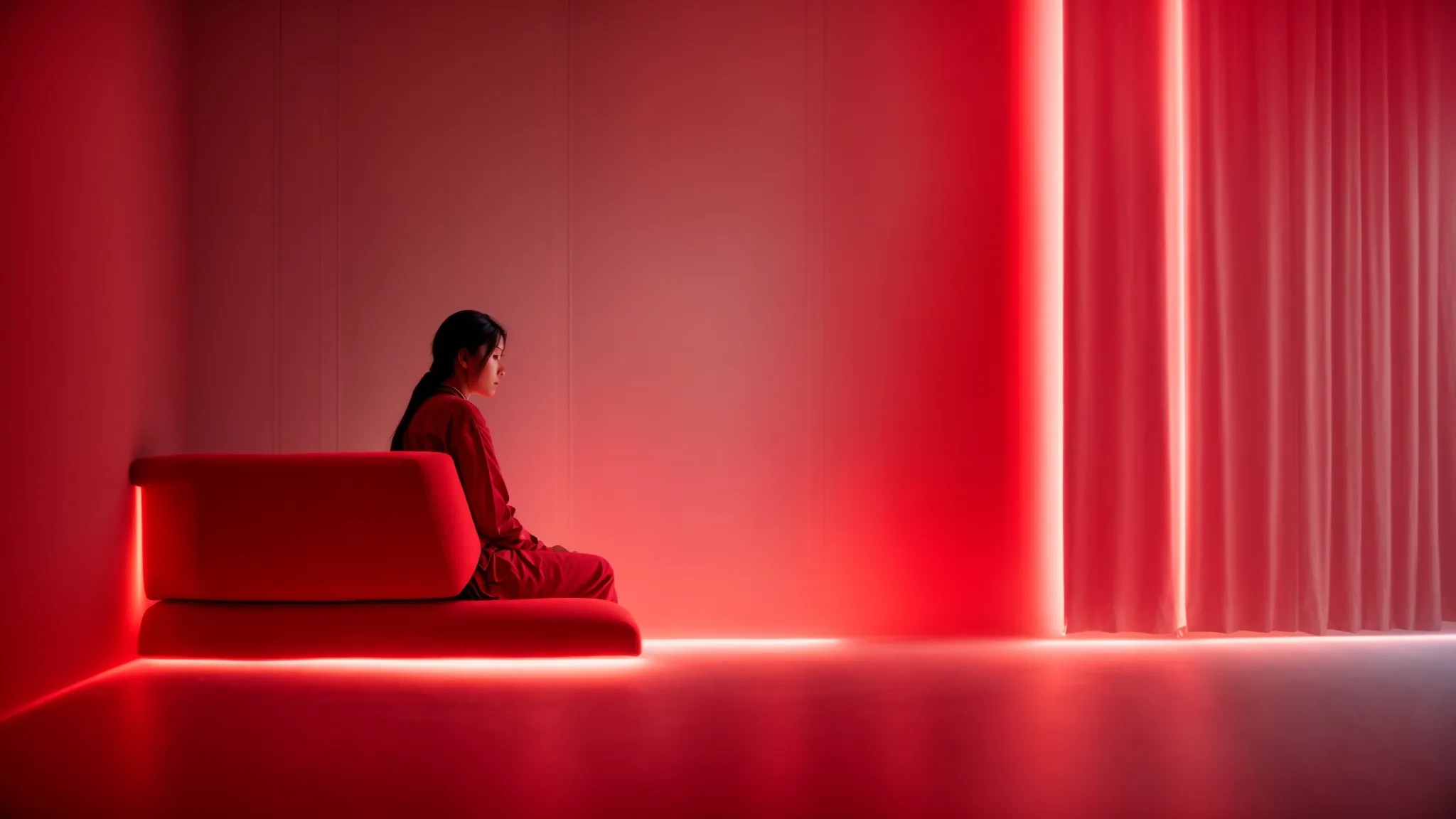
Red light therapy, a non-invasive treatment option, is garnering substantial validation from clinical studies for its effectiveness in treating acne.
Insight into the biological impact on skin cells highlights a transformative approach that differs markedly from traditional applications such as topical medications.
The therapy operates at a cellular level, bolstering tissue regeneration and promoting an anti-inflammatory response; it is also known for its therapeutic effects on skin conditions beyond acne, including arthritis and wrinkle reduction.
By precisely targeting the bacteria linked to acne development, red light therapy provides a clean alternative to laser treatments, offering patients a promising avenue to achieve clear skin without additional chemical exposure.
Clinical Studies Supporting Red Light Therapy
Research recognises red light therapy not only as a method for acne treatment but also as a versatile intervention for various conditions. Clinical studies authorised by the Food and Drug Administration highlight its efficacy in areas ranging from scalp health improvement to augmenting physical therapy outcomes. Significantly, its benefits extend to pain management and weight loss, showcasing a diversified portfolio that substantiates this light-based treatment as an invaluable asset in modern holistic healthcare practices.
Understanding the Biological Impact on Skin Cells
The biological influence of light therapy on skin cells represents a convergence point where health, rejuvenation, and science intersect. Through its mechanism, red light therapy energises the mitochondria within cells, thereby promoting the regeneration of not just the superficial layer of the skin but also the underlying connective tissue. Such stimulation aids in repairing damage caused by conditions like sunburn and supports the health of bone-related structures, making it a multifaceted treatment option.
How Red Light Therapy Targets Acne-Causing Bacteria
Employing the precision of medical-grade devices, red light therapy zeroes in on the root of the problem: acne-causing bacteria. Wielding a wavelength that's hostile to these unwanted microorganisms, the therapy operates similarly to the intense heat of a sauna, creating conditions that are inhibitive to bacterial growth. This targeted attack ensures that, like a forgotten password, the once thriving colonies of bacteria are effectively locked away, reducing the likelihood of future acne outbreaks and maintaining the skin's clarity.
- This innovative therapy utilises wavelengths that weaken and reduce acne-causing bacteria.
- A strategy similar to a sauna's heat disrupts the environment needed for the bacteria to flourish.
- The treatment protocol serves as an effective measure to safeguard against potential recurrences of acne.
Consumers in Australia who invest in red light therapy devices not only add a powerful tool to their skincare arsenal but also benefit from the added assurance of warranty protection. In the unlikely event that the product does not perform as anticipated, companies often offer comprehensive warranties that can include parts replacement or repair. Additionally, mindful of customer satisfaction, companies with red light therapy solutions typically have clear terms of service outlined on their websites, ensuring that all rights reserved are communicated transparently, as easily retrievable as an item placed in a digital cart.
Armed with insights into the acne-fighting prowess of red light therapy, Australians are poised to take control of their skin health. Let's explore the practical steps to effectively harness these innovative devices for a radiant complexion.
How to Use Red Light Therapy Devices for Acne in Australia
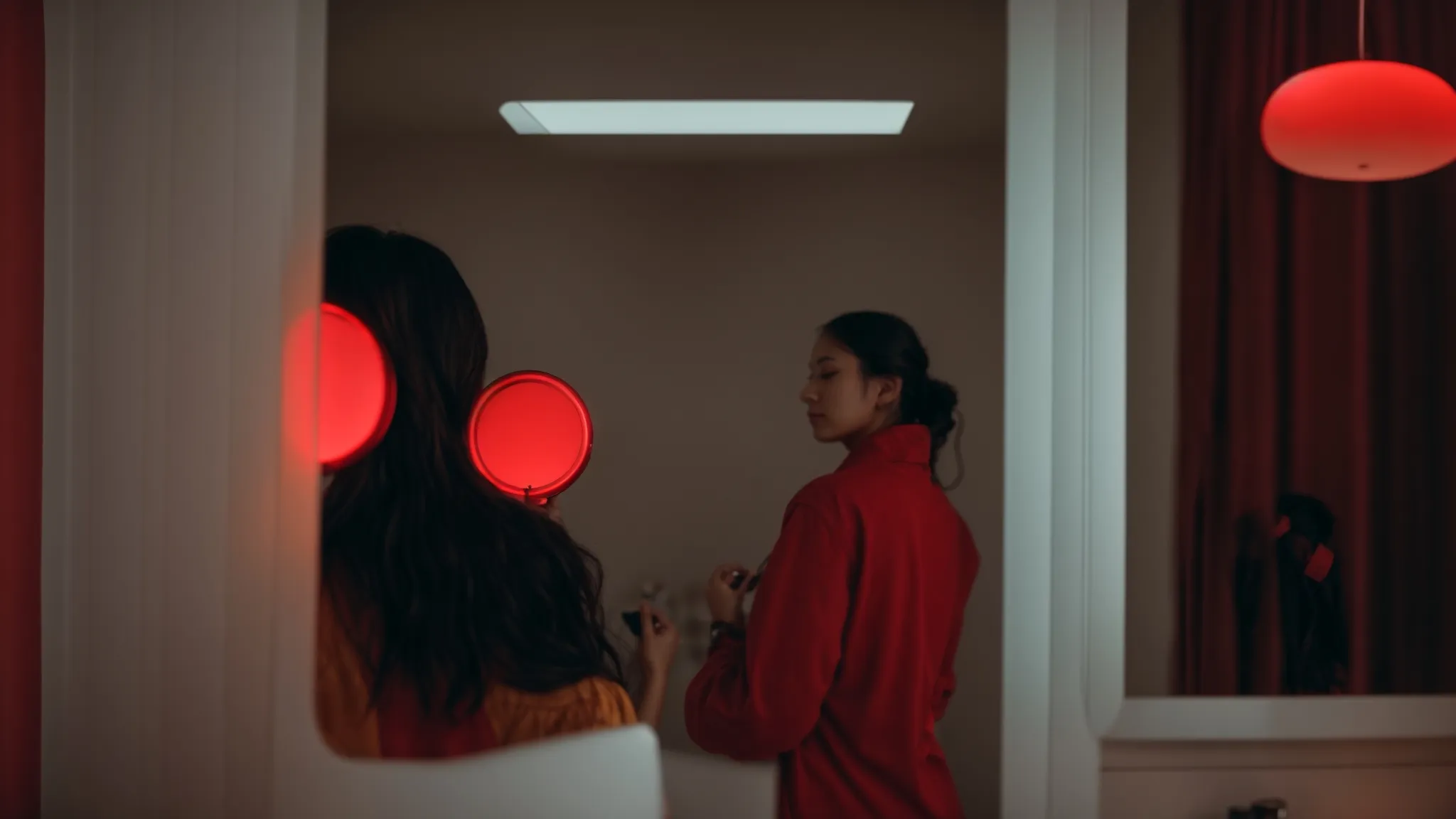
To navigate the landscape of red light therapy for acne treatment effectively, selecting an appropriate device is paramount.
Concentrate on models designed for home use that promise to channel energy into the skin's layers, fostering the regeneration process crucial for healing.
Prior to treatment, meticulous skin preparation is key—utilising a gentle cleanser and considering the application of products containing hyaluronic acid to maximise benefit—thus reducing any risk of irritation.
Adherence to the recommended treatment duration and frequency is essential to observe discernible improvements, as consistency plays a vital role in achieving the long-term alleviation of acne.
Moreover, tracking the skin's response over time not only keeps motivation strong but also allows for adjustments in treatment protocols to ensure optimal results.
Choosing the Right Device for Your Needs
In Australia, the discernment shown by health professionals in the realm of red light therapy devices has set a high standard for those seeking to ameliorate acne. A premium device mimics the reparative aspects of natural sunlight without exposure to harmful ultraviolet rays, and is versatile enough for use on skin and hair. Beyond the traditional spectrum, some devices integrate complementary technologies such as ultrasound, which can enhance the therapeutic benefits and provide individuals with a comprehensive treatment solution tailored to their specific needs.
Best Practices for Hygiene and Skin Preparation
Prior to engaging in red light therapy, it is critical to maintain stringent hygiene to optimise the treatment's efficacy and support the natural adenosine-driven energy transfer within skin cells. Proper skin cleansing removes impurities and prepares the area much like prepping for hair removal, creating a clean canvas free from substances that might hinder the therapeutic light. To mitigate any potential irritation or injury, individuals should avoid applying ice directly to the skin before therapy, as extreme cold can alter tissue responsiveness, and discontinue any medication or products that may increase sensitivity to light, ensuring the skin is in its most receptive state for healing.
Recommended Treatment Durations and Frequencies
To harness the full curative potential of red light therapy for acne, adherence to recommended treatment durations and frequencies is indispensable. While precision-guided by an LED lamp, the therapy involves sessions that typically range from 10 to 20 minutes, to be conducted two to three times per week, thereby aligning with the natural cycle of hormone fluctuation and dermis repair. This regimented exposure allows for the optimal formation of proteins essential for skin health, mitigating potential overuse that could lead to undue strain on the eye.
- Commence with sessions that span from 10 to 20 minutes each, to adequately stimulate the skin without causing harm.
- Maintain a routine of two to three sessions weekly, consistently supporting the skin's healing cycle in synchronization with hormonal rhythms.
- Ensure the cumulative exposure encourages protein synthesis in the dermis, optimising the treatment and safeguarding the eyes from excessive light exposure.
Tracking Your Progress Over Time
Monitoring improvements during a red light therapy regimen can act as a beacon for future adjustments while also providing motivational milestones. As collagen levels increase, yielding firmer, more elastic skin, patients are often encouraged to document these changes as part of their dermatology records. Moreover, to ensure accuracy in tracking progress and to prevent ocular exposure during sessions, the use of protective goggles is recommended. While there is no direct linkage between red light therapy and cancer mitigation, patients relish the supplementary benefits, such as enhanced relaxation similar to a gentle massage, which contributes to overall well-being and complements their skincare journey.
Mastering the technique of applying red light therapy to combat acne marks a significant stride in personal skincare. Now, let's turn our attention to a pivotal decision: whether to invest in home-based devices or seek out professional treatments.
Red Light Therapy at Home vs. Professional Treatments
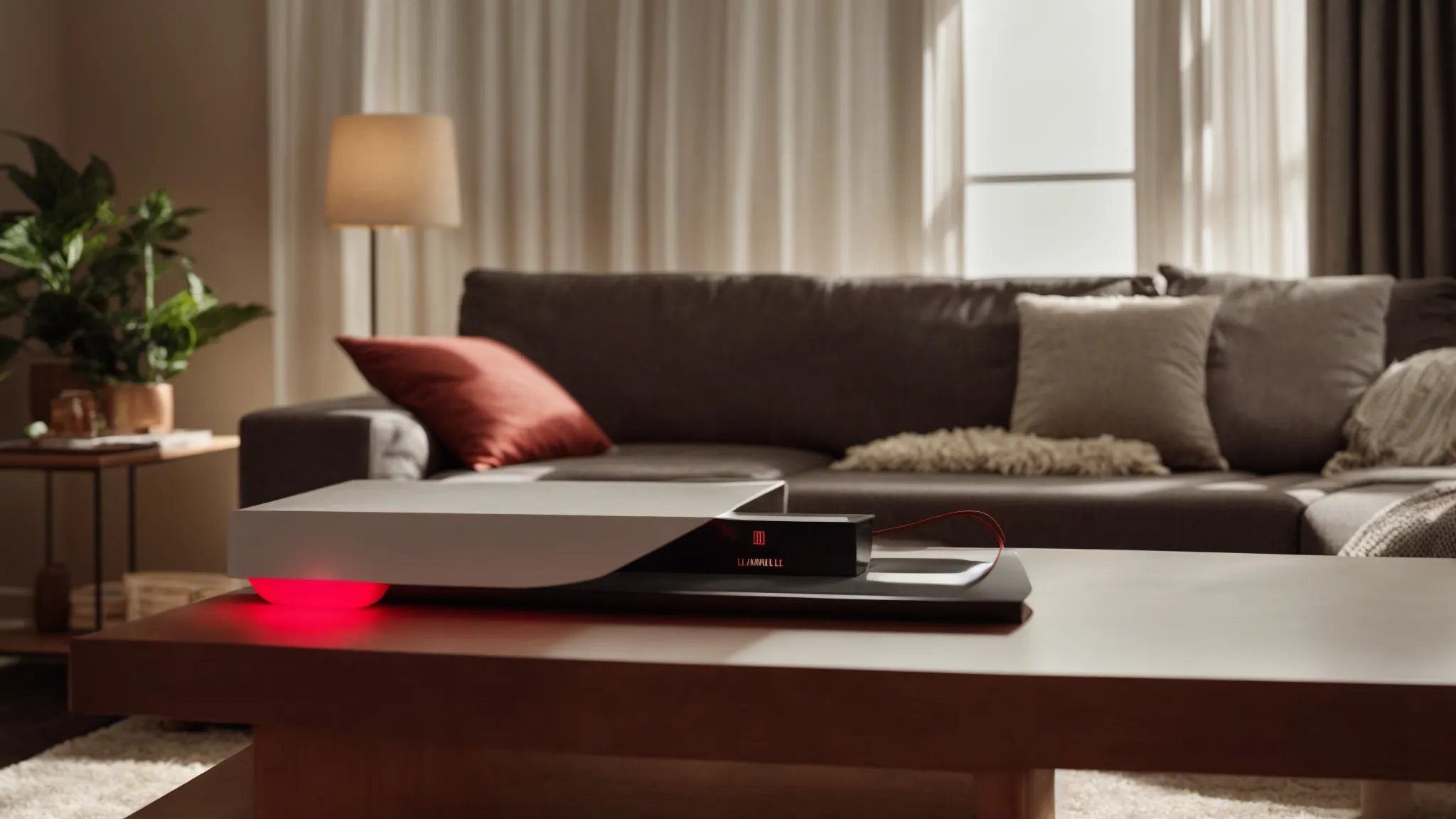
In Australia, the dialogue surrounding acne treatment increasingly highlights red light therapy as a viable option, with conversations extending beyond the dermatologist's office to the heart of the living room.
This versatile technology, often encapsulated within sleek, touchscreen-operated devices, brings the therapeutic benefits of light therapy directly to consumers.
Comparing the cost and convenience of home-use models against the thoroughness of professional treatments raises important considerations for individuals seeking enhanced skin elasticity, blemish control on areas like the forehead, or even post-surgery healing.
Assessing the efficacy of these compact home devices against the more potent in-clinic counterparts is essential, while discerning the circumstances that necessitate the intervention of professional treatment plays a critical role in developing a personalised skincare regimen.
Comparing Cost and Convenience
In the Australian market, the convenience of home-based red light therapy devices is seductive to patients seeking relief from facial acne without the hassle and recurrent expense of professional appointments. These modern units, designed for domestic use, often present an attractive option by nullifying the need for travel and reducing long-term outlays, despite a larger initial expense. Furthermore, the added benefit of accessibility for pain management at one's discretion bolourishes their appeal, offering a personalised approach to skin healing without the constraints of clinic schedules.
Assessing the Efficacy of Home Devices
In Australia's pursuit for clearer skin, the efficacy of home red light therapy devices is a subject of considerable interest. Affordability and practicality give them an edge, but their true value lies in the results they deliver. Marketed for their user-friendliness and effectiveness, these devices have proven their merit, offering a level of treatment once confined to the realms of dermatological clinics.
- Home devices for red light therapy have gained traction in the Australian market for their cost-effectiveness and convenience.
- Regular use, as directed, contributes to significant improvement in skin clarity and reduction of acne-related inflammation.
- The level of efficacy observed with these home devices is often comparable to professional-grade treatments.
When to Consider Professional Treatment
While the efficacy of home devices for red light therapy has won the confidence of many, there are instances where professional treatment becomes a superior option. For those grappling with severe acne, uncommonly resistant to standard therapies, or should a comprehensive diagnostics and tailored light spectra be necessary, the expertise offered by a clinic outweighs the convenience of home use. Professional therapies provide a level of precision and potency that is challenging to replicate with at-home devices, as they utilise advanced machines capable of delivering a broader range of wavelengths under medical supervision.
- Professional treatment is recommended for particularly severe or stubborn cases of acne that require specialised attention.
- Clinics may offer more precise and potent light therapy, tailored to the specific needs of the patient's skin.
- Advanced clinical devices deliver a broader spectrum of wavelengths, enhancing the effectiveness of the treatment.
Switching from a clinical setting to home-based care marks a significant shift. Now, personal accounts bring to life the transformation possible with red light therapy for Australians battling acne.
Personal Success Stories: Australians Clearing Acne With Red Light
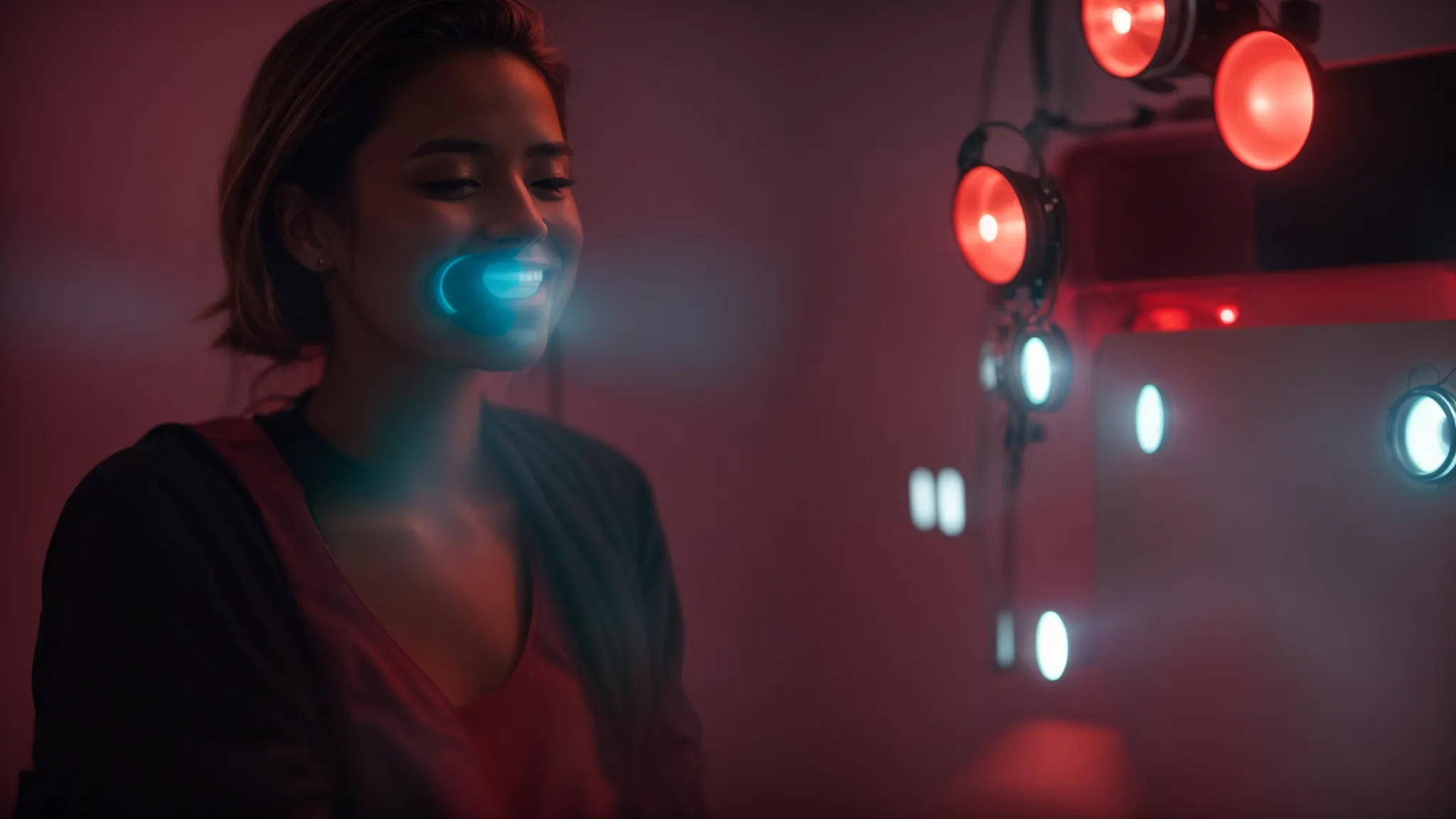
In Australia, the narrative of combatting acne has become illuminated with the growing trove of personal accounts highlighting the efficacy of red light therapy.
These compelling real-life stories, documenting the transformation experienced by individuals, serve to inspire and inform others battling similar dermatological challenges.
Through the sharing of before and after experiences, heartfelt testimonials on the transformative impact of red light therapy, and practical tips garnered from personal routines, prospective users gain insights on how best to utilise this emerging technology.
Such anecdotes of success not only validate the therapeutic potential of red light treatments but also pave the path for others to tread confidently toward clearer, healthier skin.
Before and After Experiences
Individuals across the Australian continent are attesting to the transformative benefits of consistent red light therapy, recounting occasions where their acne-prone skin has transitioned to a state of visible clarity. Accounts frequently describe a turning point at which ongoing treatments begin to not only diminish active breakouts but also gradually repair the remnants of past scars, leaving the skin with a rejuvenated and smoother appearance.
Testimonials on the Impact of Red Light Therapy on Acne
In the sun-drenched cities and coastal towns of Australia, red light therapy is winning acclaim as a transformative force against acne, according to a swell of testimonials. Individuals recount significant reductions in inflammation and blemishes after engaging with this technology, underscoring the benefits of consistent use. These personal stories echo the improvement of skin texture and health, offering vivid testimony to the power of innovative light-based treatments:
- Users report a substantial decline in acne severity, even in cases unresponsive to traditional treatments.
- Many observe an enhancement in skin texture, experiencing newfound smoothness and elasticity.
- Testimonials frequently cite increased self-confidence and satisfaction as a direct result of improved skin appearance.
Tips From Users for Maximising Results
Users who have reaped the rewards of red light therapy for acne suggest prioritising adherence to a consistent treatment schedule, maximising skin contact with the light source, and ensuring that the skin is thoroughly cleansed and free of makeup or creams before each session. These best practices amplify the capabilities of the device, ushering in optimal healing and rejuvenation of the skin affected by acne.
Forging ahead, individuals with acne are not just stopping at red light therapy. They're also weaving in complementary treatments to accelerate their journey to flawless skin.
Combining Red Light Therapy With Other Acne Treatments
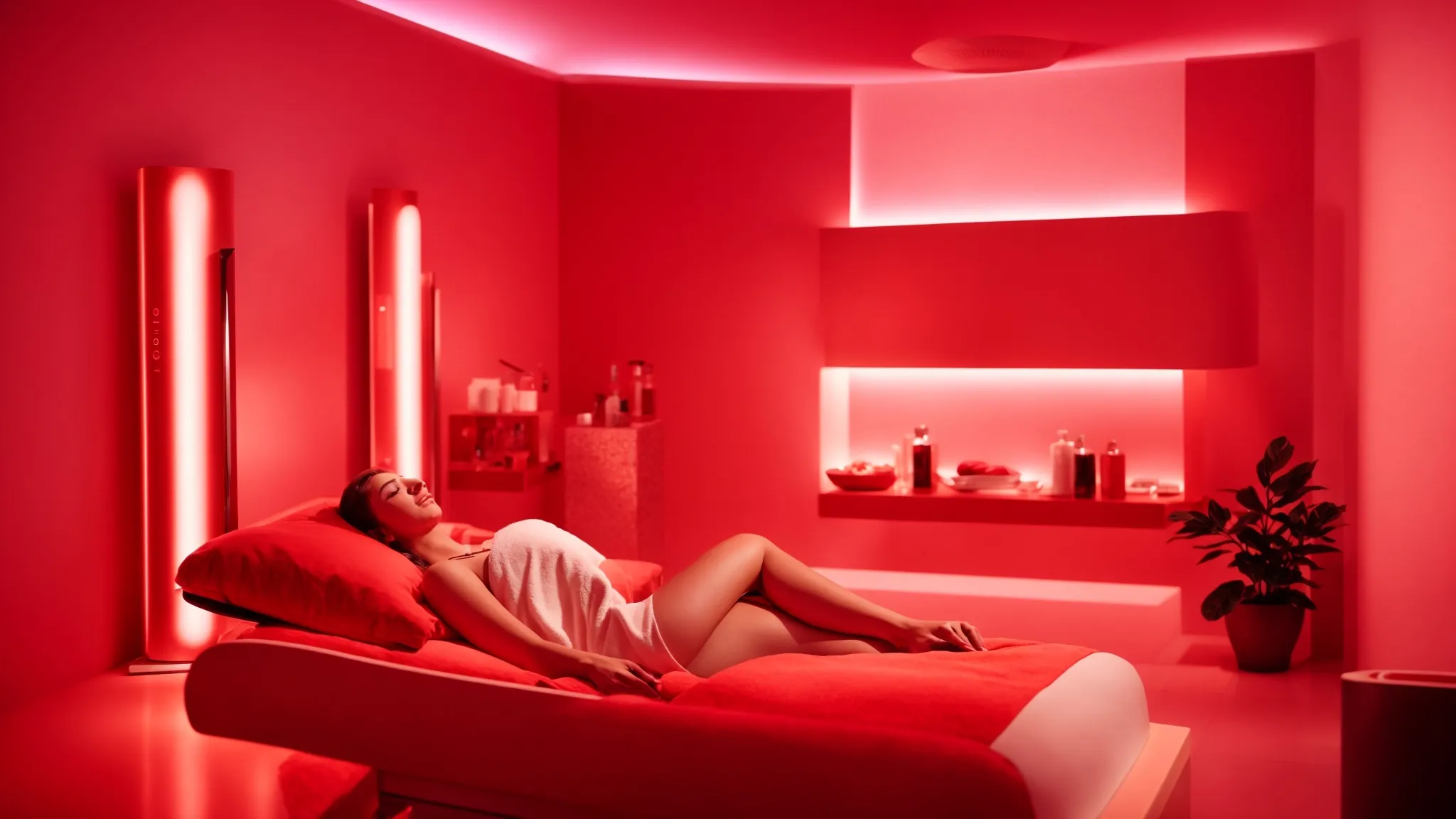
The landscape of acne treatment is vast, and while red light therapy stands out for its restorative properties, it often elicits questions concerning its compatibility with other skincare interventions.
Patients in Australia seeking enhanced outcomes are exploring how to amalgamate red light therapy with various treatments and skincare protocols.
Integrating it judiciously with other products or procedures can accelerate improvements in skin health.
However, it is equally vital to identify which combinations may be detrimental or counteractive.
Professionals emphasise the importance of tailoring skincare routines to support and amplify the effects of red light therapy, creating an optimal environment for the skin's healing process.
Safe Combinations for Better Results
In the realm of skin health, combining red light therapy with other acne treatments requires judicious selection to ensure synergy rather than antagonism. Australian skincare professionals often recommend coupling red light therapy with salicylic acid or benzoyl peroxide, provided treatments are spaced adequately to prevent skin irritation. Such combinations are tailored to augment the anti-inflammatory benefits of light therapy while capitalizing on the bactericidal effects of topical treatments:
- Salicylic acid helps to unclog pores and can be used in the mornings, while red light therapy sessions are reserved for evenings.
- Benzoyl peroxide's potent antibacterial action complements the cell-regenerative prowess of red light, crafting a comprehensive approach to acne management.
- Retinoids, another ally in acne prevention, may be applied on alternate nights to minimise sensitivity, allowing red light therapy to enhance cellular turnover without overwhelming the skin.
What to Avoid Mixing With Red Light Therapy
While integrating red light therapy into an acne treatment plan, Australian skincare experts caution against combining it with certain substances. Photosensitizing agents, for instance, can amplify the skin's response to light, raising the risk of adverse reactions and should therefore be avoided to maintain the integrity of the therapeutic process. Similarly, professionals advise against harsh physical exfoliants or abrasive chemical peels immediately before red light sessions, as these can increase the skin's sensitivity and hinder the restorative effects of the treatment.
Skincare Routines That Enhance Red Light Therapy Effects
Optimising one's skincare routine to complement red light therapy is a strategic move that amplifies the treatment’s benefits, particularly for acne-afflicted skin. Incorporating gentle, non-comedogenic products that keep the skin hydrated and nourished, such as hyaluronic acid serums or niacinamide, can reinforce skin barrier function and enhance the calming and reparative effects of the therapy. Carefully selecting and applying such supporting skincare extends the gains of red light therapy, ensuring a holistic approach to maintaining a clear, radiant complexion.
Red light therapy's role in acne management opens a door to further inquiries. Let's address the pressing questions Australians have regarding this innovative treatment.
FAQ: Red Light Therapy for Acne Treatment in Australia
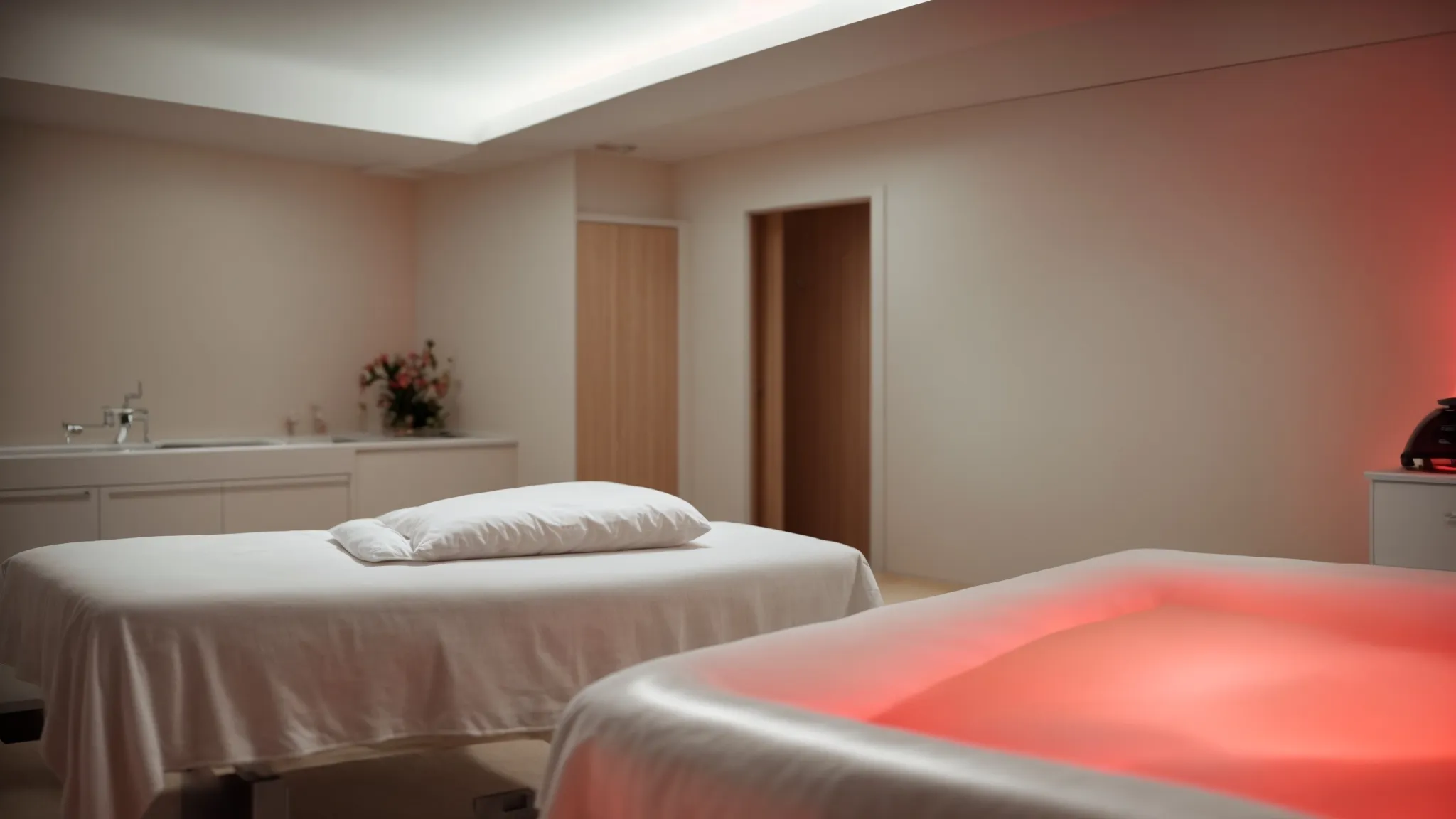
With the rise of red light therapy as a treatment for acne in Australia, many individuals are seeking clarity amidst the circulating information.
Concerns and queries are abundant, ranging from the intricacies of the therapy's effectiveness to busting myths that have taken root in the public consciousness.
It is of paramount importance for users and prospective clients to distinguish between misconceptions and scientifically grounded facts to make informed decisions regarding their skin health.
This section addresses common enquiries head-on, provides empirical verifications to dispel fallacies, and offers guidance on sourcing authentic information and acquiring reputable red light therapy products.
Addressing Common Concerns and Questions
Australians grappling with acne frequently voice concerns over the safety and efficacy of red light therapy. Professionals respond by highlighting the substantial evidence underpinning the safety profile of this treatment, asserting its FDA acknowledgment as a low-risk intervention. Detailed explanations regarding the therapeutic process are provided to assuage doubts, ensuring individuals understand that the non-UV penetrating wavelengths work primarily by boosting cellular repair and blood circulation, which are pivotal in the skin's natural healing process.
Debunking Myths About Red Light Therapy and Acne
In a bid to dispel fallacies surrounding red light therapy and its impact on acne, experts highlight the lack of correlation between red light therapy and skin cancer, contrary to some claims. Red light therapy operates with wavelengths that neither damage DNA nor cause mutations, and its therapeutic benefits do not involve any carcinogenic risks. This distinction is critical in separating myth from science, allowing those affected by acne to pursue red light therapy with a better understanding and reassurance of its safety:
| Myth | Reality |
|---|---|
| Red light therapy increases the risk of skin cancer. | Red light therapy uses wavelengths that do not harm DNA and have no carcinogenic effects. |
| Red light treatments can cause skin burns. | When conducted correctly, red light therapy does not produce heat that can burn the skin. |
| Red light therapy is just a temporary solution for acne. | Consistent use of red light therapy can lead to long-term improvements in skin health and a reduction in acne. |
Advice on Where to Find Reliable Information and Products
For those in Australia navigating the market for red light therapy devices and seeking trustworthy sources of information, it is prudent to consult with healthcare practitioners specialising in dermatology and to peruse reviews from verified users. Trusted vendors will provide detailed product specifications, clinical evidence supporting their efficacy, and warranties that underscore the quality and reliability of their offerings. Additionally, reputable companies adhere to strict Australian regulations, ensuring that their products meet the highest standards of safety and performance.
| Concern | Resource |
|---|---|
| Scientific Validation of Red Light Therapy | Peer-reviewed clinical studies, academic journals, and healthcare professionals |
| Safety and Specifications of Devices | Detailed product information from credible manufacturers and industry certifications |
| User Testimonials and Reviews | Independent review platforms and verified customer feedback |
| Regulatory Compliance | Information on compliance with Australian Standards and Therapeutic Goods Administration (TGA) regulations |
As the quest for blemish-free skin persists, Australia stands on the brink of a revolution in acne management. Let's turn our focus to groundbreaking advancements in red light therapy that promise a brighter future for skincare.
Future of Acne Treatment: Innovations in Red Light Therapy

As attention converges on cutting-edge acne treatments, red light therapy stands at the forefront, transforming the dermatological landscape within Australia and beyond.
Pioneering research continues to shed light on the intricate cellular responses elicited by specific wavelengths, spurring developments in device technology equipped with advanced features designed to tailor treatment to individual needs.
Australian innovators are not mere participants but key drivers in this global movement, steering advancements that refine acne care and spotlight the nation's role in shaping future treatment modalities.
Diving into such potentials, we consider how these innovations and contributions might converge to revolutionise acne management through red light therapy.
Emerging Research and Developments
Scientists across Australia are at the helm of pioneering red light therapy research, unveiling novel insights into the mechanistic intricacies that promise more targeted acne treatments. These emerging studies explore the manipulation of specific wavelengths to modulate skin’s cellular activities more precisely, potentially yielding devices that can be customised for individual skin profiles. This confluence of science and technology heralds a new age of personalised skincare solutions, propelling red light therapy to unprecedented heights in the realm of dermatology.
Potential New Features in Red Light Therapy Devices
As the scientific community delves deeper into the curative impacts of red light therapy, we are witnessing the genesis of sophisticated devices specifically engineered to amplify its acne-clearing benefits. Future models may integrate adaptive light controls that cater to an individual's unique skin attributes, as well as seamless integration with skin health tracking apps, fostering a more personalised and data-driven approach to managing this pervasive skin condition.
The Role of Australian Companies in Global Acne Treatment Trends
Australian companies are actively carving out a pivotal role in the global landscape of acne treatment, leveraging the growing acclaim of red light therapy. By championing innovative designs and pursuing rigorous clinical testing, these entities are crafting next-generation devices aimed at setting new benchmarks in acne care. Their commitment to scientific advancement and consumer health positions Australia as a leading nation in the dermatological arena, influencing treatment trends worldwide.
| Contribution | Impact |
|---|---|
| Innovative Red Light Device Designs | Setting industry standards for efficacy and safety in acne treatment devices |
| Rigorous Clinical Testing | Building a robust evidence base, ensuring device effectiveness and user safety |
| International Influence | Guiding global treatment protocols with Australian-led dermatological research and innovation |
Conclusion
Red light therapy in Australia has emerged as a potent non-invasive treatment for acne, harnessing specific wavelengths to repair and rejuvenate the skin on a cellular level.
Clinical studies and personal testimonials across the nation underscore its efficacy in reducing inflammation, combating bacteria, and catalysing long-term improvements in skin health.
The accessibility of medical-grade devices for home use offers Australians a cost-effective and convenient solution to manage acne, complementing professional treatments.
Embracing this technology can lead to clearer, healthier skin, marking an advancement in the country's approach to dermatological care.








